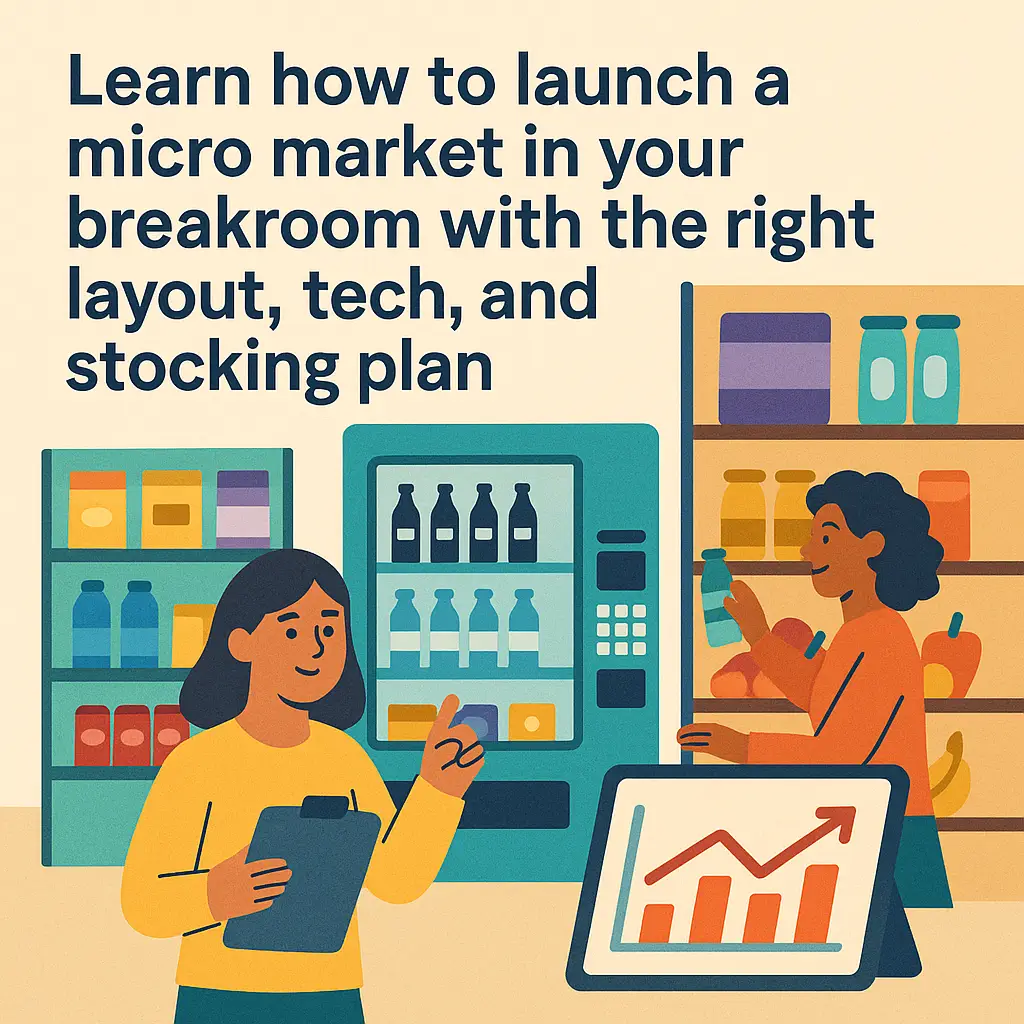How to Set Up a Micro Market in Your Office
Learn how to launch a micro market in your breakroom with the right layout, tech, and stocking plan.
Back to Micro Market Services ResourcesLearn how to launch a micro market in your breakroom with the right layout, tech, and stocking plan.
Back to Micro Market Services ResourcesMicro markets are highly adaptable and typically require at least 50 square feet—sufficient for coolers, shelving, and a checkout kiosk. Optimal space allows easy circulation and a professional presentation. Breakroom corners and underused walls are ideal setup areas in most offices.
![]() Open layouts allow for flexible placement in most breakroom sizes
Open layouts allow for flexible placement in most breakroom sizes
![]() Smart tech simplifies restocking and improves inventory accuracy
Smart tech simplifies restocking and improves inventory accuracy
![]() Micro markets boost employee satisfaction and reduce off-site trips
Micro markets boost employee satisfaction and reduce off-site trips

Setting up a micro market in your office is an easy way to boost employee satisfaction while offering convenient access to food and drinks. Unlike traditional vending machines, micro markets create a self-service retail environment with open shelving, coolers, and smart checkout systems—perfect for modern workplaces.
The first step is evaluating your breakroom layout. A functional micro market typically requires at least 50 to 75 square feet of space. Look for wall access for coolers and adequate floor space for shelving and the payment kiosk. Layout flexibility means you can tailor the design to your space, whether it's in a corner or centered in a communal area.
Next, consider your equipment needs. Most installations include glass-door coolers for beverages and meals, shelving for dry goods, and a self-checkout kiosk. Depending on your office size, you may also opt for AI-enabled coolers or contactless payment kiosks for added convenience. Many modern systems also include backend software that helps vendors track inventory and consumption trends for efficient restocking.
Security is another key consideration. Micro markets operate on an honor system, but features like 24/7 camera monitoring, locked coolers, and restricted payment kiosks help reduce theft. Make sure your provider offers safeguards suitable for your environment.
Stocking variety should appeal to a range of preferences, from classic snacks and energy drinks to healthy options and full shelf-stable meals. Your vendor will typically handle product selection and updates based on popularity and consumption analytics. Managed service plans can even ensure your market is always stocked and functioning smoothly.
If you'd like to better understand vendor service levels, check out our guide on how to choose a vending management partner. For mixed-use spaces like residential buildings, you can also explore the benefits of vending in apartments and shared facilities.
If you're exploring vending options for your business, Vending Exchange can help simplify the process. Delivery, Installation and Equipment is provided at no cost to you - vendors provide the machines, keep them stocked, and handle all servicing. Whether you need a provider or full-service management, just fill out the form on this page to get started.
Most micro markets require 50–75 square feet, depending on layout and equipment chosen.
Yes, micro markets are modular and can be customized to fit tight or awkward spaces.
Standard equipment includes coolers, dry-good shelving, and a self-checkout kiosk. Add-ons include AI coolers or security cameras.
Smart systems automatically inform vendors when items run low, ensuring timely restocks and reducing manual tracking.
Local vending providers handle all stocking, servicing, and equipment maintenance as part of their offering.
Theft risk is minimal with proper safeguards, including cameras, locked coolers, and cashierless checkouts with traceable payments.
Yes, most providers offer a wide range of snacks and meals including vegan, gluten-free, and healthy choices.
Most installs are completed within one week after site approval and space assessment.
Yes, modern micro markets support contactless cards, mobile wallets, and scan-to-pay systems.
For qualifying locations, installation, equipment, and delivery are provided at no cost by vending providers.